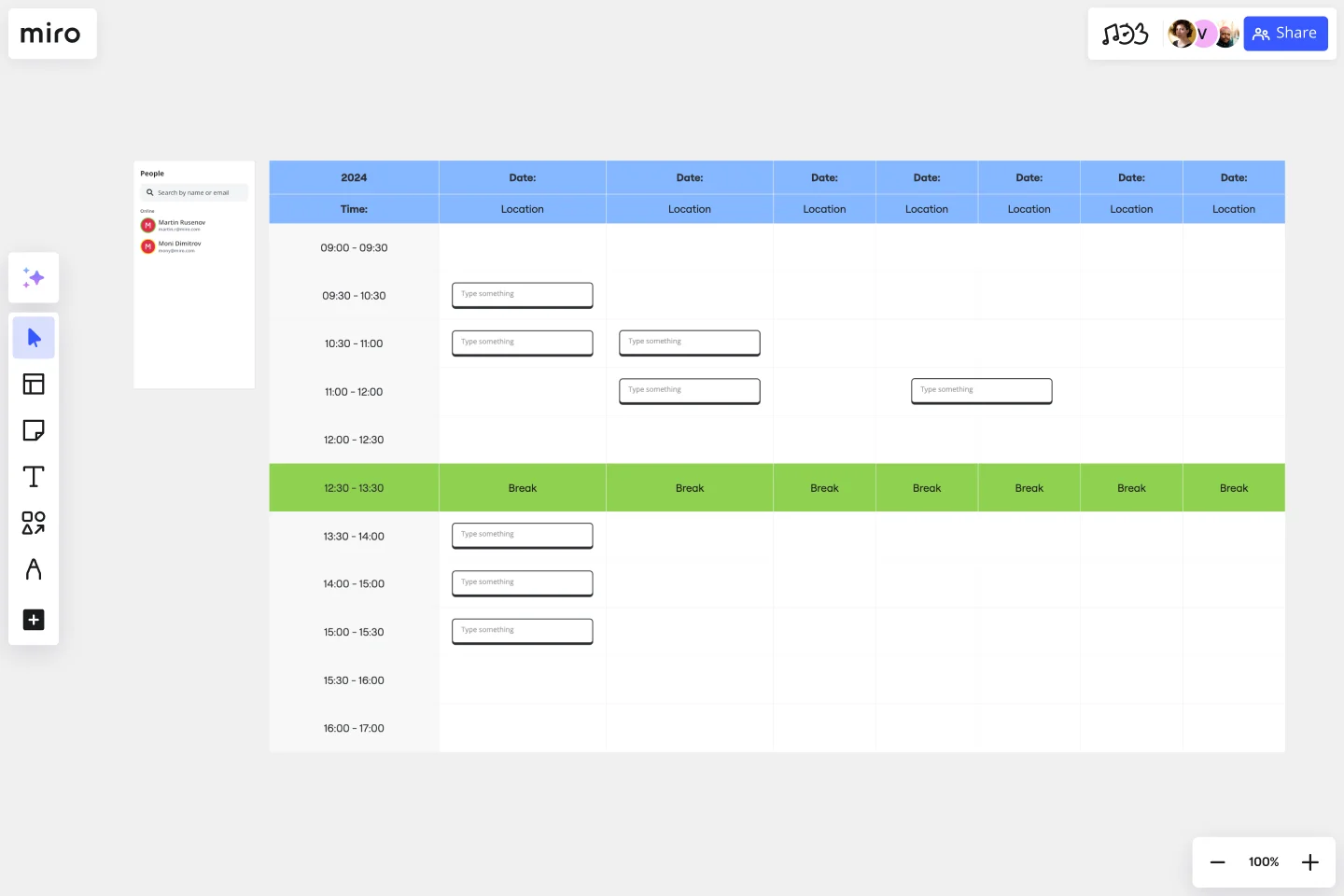Schedule Template
Streamline your time management with the schedule template.
About the Schedule Template
Scheduling is the backbone of many successful projects, events, and daily routines. Whether you're mapping out a conference, planning a project timeline, or simply organizing your week, a visual representation can make all the difference. Enter the schedule template, a universal tool to simplify your time management process.
What's a schedule template?
A schedule template is a pre-formatted visual layout that allows users to plot out time-specific events, tasks, or activities over a set duration. It's akin to a calendar or planner but is often more flexible, allowing for customization based on specific needs or projects.
How to use the schedule template in Miro
Follow these simple steps to use the schedule template effectively:
Edit time slots: Click on any time slot you wish to change. You can adjust the duration or rename it with just a few clicks.
Adjust the overall timeframe: If you need a broader or narrower view, change the timeframe to reflect days, weeks, or even months.
Add specific events: Click on the desired slot and input the event, task, or activity you wish to schedule.
Integrate other documents: Drag and drop any artifact to your board, such as images, links, or any other documentation, when needed.
Color-code and customize: Use different colors to categorize or prioritize various events or tasks for added clarity.
Save and share: Once your schedule is tailored to your needs, save it and share it with your team for seamless collaboration.
Why should you use a schedule template?
Efficiency: A visual layout enables quicker planning and adjustments, saving time in the long run.
Clarity: A well-organized template provides a clear overview of tasks, reducing the risk of overlaps or missed appointments.
Flexibility: Adjust the template to fit various timeframes, whether a week, a month, or a custom duration.
Collaboration: Sharing the schedule allows teams to align, ensuring everyone is on the same page.
Customization: Beyond time management, you can integrate other docs and visual elements to provide context or enhance understanding.
Can I adjust the time intervals on the template?
Absolutely. The template is designed to be adaptable, allowing users to customize the intervals per their needs.
Is it possible to color-code events or tasks?
Yes, color-coding is an option to visually categorize or prioritize different events, making the schedule even more intuitive.
How can I share my schedule with others?
Sharing is easy. Once your schedule is set, you can provide access to anyone, enabling seamless collaboration by sharing your board link.
Are there options for recurring events or tasks?
While the template allows individual event input, users can easily replicate or duplicate events to indicate recurrences.
Get started with this template right now.
Risk Assessment Template
Works best for:
Leadership, Project Management, Decision Making
Every business faces risk. The more you factor it into your decisions early on, the better prepared you’ll be to avoid, absorb, or mitigate the risks you encounter. Use Miro’s risk assessment template to collaborate on a clear-eyed risk assessment that ensures you’ll never be caught unawares.
UX Project Canvas Template
Works best for:
User Experience, UX Design, Market Research
Inspired by Alexander Osterwalder's 2005 business model canvas, the project canvas will help your team visualize the big picture of your UX and design projects, providing a convenient structure that holds all of your important data. This innovative tool enables you to transform an idea into a project plan, stimulating collaboration and communication between collaborators. Unlike alternative models, the project canvas is a simple interface. There are few startup costs, and employees can easily be brought up to speed to start using the canvas quickly.
Timeline Workflow
Works best for:
Project Management, Flowcharts, Operations
A timeline is a visual tool that chronologically plots out projects step by step. It’s an ideal tool for your team to tell stories (such as an overview of events in your organization) and visualize your projects or processes. The Timeline Workflow template is perfect for any project that relies on visual content. You may find it beneficial to use with your team and also to share with other stakeholders or clients to keep them in the loop on your progress.
Project Proposal Template
Works best for:
Project Management, Documentation, Project Planning
For any type of project, the Project Proposal template can be a crucial step toward clarifying the context, goals, and scope of a project to get stakeholder buy-in. A project proposal outlines what you want to accomplish, your goals, and how you plan to achieve them. Generally, a project proposal gives the reader some context on the project, explains why it is important, and lists the actions that you will take to complete it. Project proposals have myriad uses. Often, businesses use project proposals to get external buy-in from a donor or outside stakeholder. But many companies draw up project proposals for internal buy-in too.
Go-to-Market GTM Template | Miro
Works best for:
Marketing, Desk Research, Strategic Planning
It doesn’t matter how innovative or effective a new product is — if it doesn’t get noticed and adopted by the right audience, the product won’t get off the ground. That’s where your Go-to-Market Strategy comes in. It’s a single resource that houses all of your research, insights, and data, and includes your business plan, target audience, marketing approach, and sales strategy. A GTM is especially important for any startups who grow fast, have to make split-second decisions, and have to be fully in sync.
Company Organization Chart
Works best for:
Org Charts, Operations, Mapping
The Company Organization Chart template enables clear visualization of hierarchical structures within an organization. It helps teams understand reporting lines, roles, and responsibilities, fostering transparency and alignment. With customizable features, such as color-coding and labeling, this template facilitates effective communication and decision-making across departments and levels.
